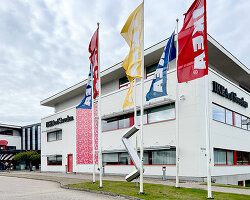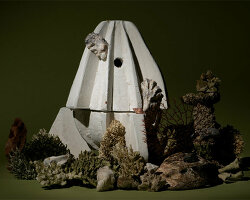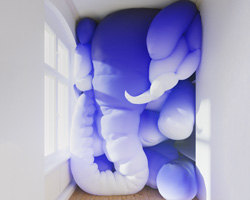since its founding in 2015 as IKEA’s research and design laboratory, SPACE10 has been actively involved in exploring and understanding the urban environment. from flat-pack gardens to self-driving car concepts, the copenhagen-based studio has proposed a series of innovative solutions to the issues that are expected to affect our cities in the years to come. ‘the work of SPACE10 influences IKEA both directly and indirectly,’ simon caspersen, SPACE10’s co-founder tells designboom. ‘what SPACE10 brings to IKEA is an outside-in approach to innovation, and another possibility to pursue radical solutions, beyond what might come intuitively to the IKEA organization of today.’

the urban village project by SPACE10 and EFFEKT architects | read more on designboom here
the ideal city / p.251 / SPACE10 + gestalten 2021
for its latest project, SPACE10 brought together a host of world-renowned experts as part of a new 256-page publication. titled ‘the ideal city’, the book — published by gestalten — seeks to showcase a diverse range of solutions and approaches. ‘the book is a holistic exemplar of projects from around the world that can inspire architects, designers, city-makers, placemakers, communities, and the like towards better urban futures — through a shared idealism — not a shared form,’ caspersen continues.
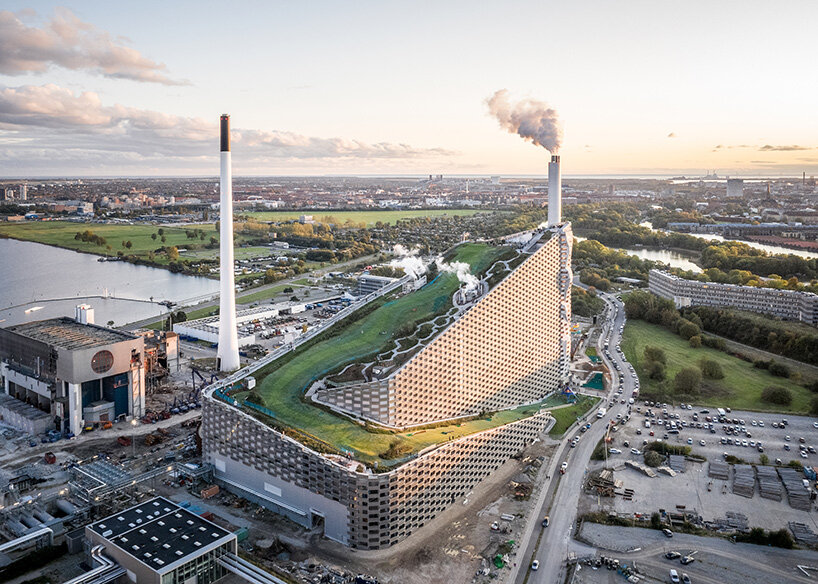
copenhill by BIG-bjarke ingels group | read more on designboom here
image by rasmus hjortshøj | the ideal city / p.23 / SPACE10 + gestalten 2021
in this exclusive interview, simon caspersen discusses how he and the SPACE10 team put the book together, and what effect the pandemic has had on the studio’s vision. ‘in just one year, the pandemic has taught us that there is no such thing as an ‘impossible task’,’ caspersen tells us. ‘talk of the new normal should be left behind. we have seen and experienced that governments around the world can act together, and that people can change their behavior, in a very short amount of time. that should make us stubbornly optimistic about our collective capacity to join together to create a more hopeful future.’ read the full interview below.

parking house + konditaget lüders by JAJA architects
image by rasmus hjortshøj | the ideal city / p.225 / SPACE10 + gestalten 2021
designboom (DB): can you start by touching on the core principles of ‘the ideal city’?
simon caspersen (SC): we started by defining five guiding principles that we believe are the building blocks for creating cities that feel better for more people to live in. cities that are greener, healthier, more sustainable, inclusive, and safe. cities that boost our quality of life, ensure more fulfilling ways of living together and provide better opportunities for the many. cities that are more resilient and economically productive, while tackling the climate crisis head on. in doing so we touched on five main pillars that can help in shaping a better city for tomorrow. they should be resourceful, accessible, shared, safe, and desirable.
1. resourceful. a city should ideally be self-sufficient and circular, which means both ecologically and economically sustainable; 2. accessible: an accessible city is built for diversity, inclusion, and equality, while providing affordable housing for all in mixed neighborhoods; 3. shared: a shared city encourages a sense of community, collaboration, and togetherness. from co-living communities to shared mobility; 4. safe: resilience to climate change, a city that boosts our health, and provides safety for all — not just the majority or a privileged few — along with an emphasis on crime prevention and rehabilitation; 5. desirable: a desirable city is one that is a pleasure to be in. it is designed on a human scale, making everything accessible within a 15-minute walk. it is a city that encourages the playful side of humans by promoting curiosity, wonder and discovery. it nurtures a vibrant public life, with access to culture, art, and activities, as well as appealing public spaces for relaxation, well-being, and learning.

superkilen park by BIG-bjarke ingels group | read more on designboom here
image by iwan baan | the ideal city / p.19 / SPACE10 + gestalten 2021
DB: the book explores more than 50 different cities around the world. how were these cities chosen?
SC: ‘the ideal city’ takes readers to 53 different cities around the world to introduce realized projects that show that all ideas are implementable today. we sought to find specific examples within each city, and showcase projects as large as a city-wide masterplan to others as small as a street tile. we feature projects on innovative food and energy production to schemes for diverse and inclusive housing and mobility. it’s quite diverse.
we think the uniqueness of this book is the holistic and multidisciplinary approach to rethinking cities, so beyond projects from 53 different cities; we also sat down with the pioneers who inspire us — from legendary urban designer jan gehl to transportation entrepreneur robin chase; from starchitect bjarke ingels to the interdisciplinary design studio urban think tank; and from the largest intergovernmental organization, the united nations, to a small community-led alternative policing program in the kwanlin dün first nation in canada, to hear their thoughts on a more optimistic future for our shared home: the city.

grotão community center by urban-think tank | read more on designboom here
the ideal city / p.73 / SPACE10 + gestalten 2021
DB: in compiling the book, were you surprised by the livability of any of the cities featured?
SC: the good news is that it was incredibly hard to make a final selection of which projects to include in the book as there are so many inspiring initiatives taking place around the world. it’s also hard to pick among the projects selected in the book, but I will share two types of projects that stand out to me personally.
first are projects that have been initiated bottom up by engaged citizens who drove the change they wanted to see in their urban environment and did not wait for architects, city planners, developers or politicians to make it happen for them. in this category we find projects like: schoonship [p. 34, the ideal city]; new ground co-housing (older women’s co-housing) [p. 132]; and michigan urban farming initiative [p 146]. all three are examples of aspirational, purpose-driven, sustainable, community-oriented projects that create a more livable, resourceful city. I highlight these because they are initiated by ordinary citizens themselves.

regional market by atelier masomi | read more on designboom here
image by maurice ascani | the ideal city / p.231 / SPACE10 + gestalten 2021
SC (continued): the second category of projects I want to highlight demonstrates that positive long lasting change doesn’t require major budgets that can only happen in privileged welfare states. here we have the regional market by atelier masomi [p. 230]. the architecture firm built a permanent regional market in the village of dandaji with canopies made of cheap and recycled materials. colorful, recycled metal disks provide shade usually cast by trees in less severe climates, while arranging them at different levels ensures good ventilation. the compressed earth bricks used for the stalls have similar cooling advantages of the more traditional adobe, but at a fraction of the cost. the intervention has boosted the local economy.
educating girls is one of the most powerful solutions to climate change. the avasara academy [p. 54] for economically disadvantaged young women and girls had a limited budget which meant the architects used reclaimed materials from nearby demolished buildings and the mosaic paving is made of stones sourced from quarry waste. the avasara academy highlights the role architecture plays in creating affordable, accessible, and inclusive educational solutions for communities, that feel good to be in.
finally, the profile on yasmeen lari [p 80] shows how yasmeen has developed low carbon and low cost structures that can withstand earthquakes and floods, in what she calls ‘barefoot architecture’ that treads lightly on the planet. she works directly with marginalized communities by supplying the technical knowledge and training for people to take charge of their lives and build structures that are resilient to and prepared for frequent extreme weather. so far, over 45,000 green shelters have been constructed through lari’s outreach, making her work the world’s largest zero carbon shelter program. I really like her point on how we often misunderstand what kind of help is needed, and the western ‘aid mindset’ is to think of everyone as helpless victims who need things done for them, but that we have to help people to do things for themselves. there’s so much that can be done with what’s already there — using 10 times less money.

avasara academy by case design | read more on designboom here
image by ariel huber | the ideal city / p.55 / SPACE10 + gestalten 2021
DB: can a good solution in one city always be applied to another, or does each city have to adapt solutions to suit its own context?
SC: cities are complex ecosystems that need to be approached through a case-by-case basis. there is no one size fits all solution to cities, nor is there one toolbox/toolkit that can solve the multitude of challenges that cities face today. what makes sense in dandaji, niger might not make sense in detroit, or what works in caracas might not work in cairo. the book is a holistic exemplar of projects from around the world that can inspire architects, designers, city-makers, placemakers, communities, and the like towards better urban futures — through a shared idealism — not a shared form.
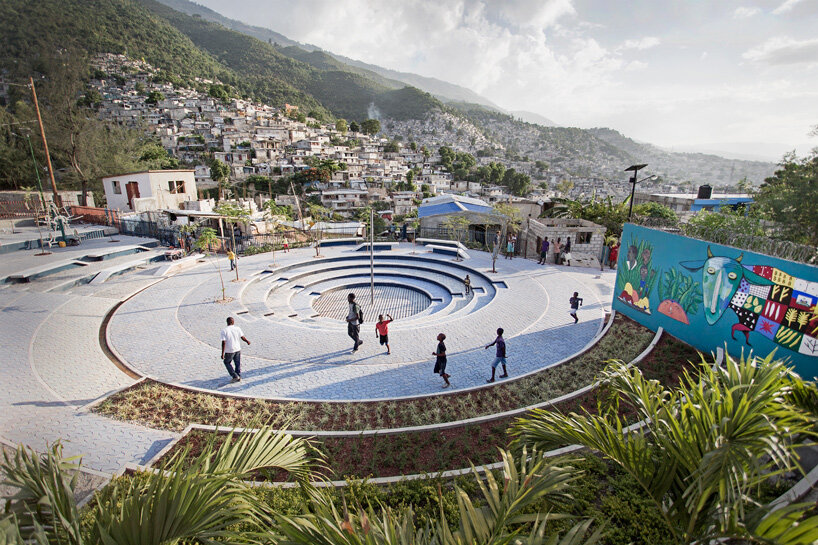
tapis rouge by EVA studio
image by gianluca stefani | the ideal city / p.190 / SPACE10 + gestalten 2021
DB: in what ways has the past year changed or strengthened SPACE10’s approach to urban environments?
SC: in just one year, the pandemic has taught us that there is no such thing as an ‘impossible task’. now is the time to accelerate the transition to safer cities, to protect the future of both humanity and the planet. the global upheaval this past year has thrown our everyday lives into chaos, but it has also made us reflect on what’s important. we need to apply our learnings from the pandemic to our other pressing challenges: protecting and preserving the natural environment, addressing deeply entrenched inequalities, and creating open, desirable, and secure places for all to live.
talk of the new normal should be left behind. we have seen and experienced that governments around the world can act together, and that people can change their behavior, in a very short amount of time. that should make us stubbornly optimistic about our collective capacity to join together to create a more hopeful future.

image by niklas adrian vindelev
DB: do you think the pandemic has changed how the future of our cities will evolve?
SC: in our view, covid-19 hasn’t resulted in new needs in city planning, but accelerated needs already existing — from making cities more pedestrian and bike friendly, better public spaces to ensure work, healthcare, education, and other activities that can be reached within a 15-minute walk of the home. how do we embrace and build our cities after we’ve been at home for so long? it is an especially interesting topic to explore based now on the new needs, aspirations, and priorities people have after this time of pause and reflection.
beyond covid-19, we are also facing an accelerating climate crisis, growing inequality, lack of access to affordable homes, and lack of equal opportunities for all. cities are right at the heart of the problem, and therefore also at the heart of the solution. ‘the ideal city’ takes a very holistic approach and focuses on the solutions to future-proofing our cities.

image by niklas adrian vindelev
DB: who is the book targeted towards, and in what ways do you hope it impacts them?
SC: the book is for everyone, everywhere who is interested in how we can build better cities for tomorrow. it is meant to inspire and spark dialogue for change. the book shows that there’s an urgent need to rethink how we design, build, finance and share our future homes, neighborhoods and cities, while also sharing tangible examples of how cities around the world are embracing new ways forward. the challenges are extensive but so are the opportunities. by talking to experts and visionary creatives we showcase how local solutions can be created to help solve global challenges to enable better city futures.

image by niklas adrian vindelev
DB: what direct influence does this book, and SPACE10’s work in general, have on IKEA?
SC: SPACE10 is a research and design lab on a mission to enable a better everyday life for people and the planet. we research and design innovative solutions to some of the major shifts expected to affect people and our planet in the years to come, and are proudly supported by and entirely dedicated to IKEA.
the work of SPACE10 influences IKEA both directly and indirectly. what SPACE10 brings to IKEA is an outside-in approach to innovation, and another possibility to pursue radical solutions, beyond what might come intuitively to the IKEA organization of today. we’re set up as an external and independent research and design lab, yet we are entirely dedicated to IKEA. we look into new directions and contribute to making IKEA on the forefront and ready for change — and change seems to be the only constant in the fast paced world we live in.
while this research project is too early to say what will be the direct outcome — we felt this was an important book for the world right now, which was why we created it, and hopefully it will inspire IKEA and beyond. IKEA is however a curious company and has now started a collaboration with the entire city of helsingborg. so hopefully SPACE10 can contribute to this exploration as well.

image by niklas adrian vindelev
DB: how important is it to actively involve the general public in the future design of our cities?
SC: we feel it is very important. we hope that when designing future cities, it will always start with a local conversation that asks people who actually have to live there: ‘what kind of cities do you want to live in? what do you believe is important for a good life? and what makes a good home for all of us?’

SPACE10’s jana perkovic and simon caspersen | image by niklas adrian vindelev
DB: are you optimistic about the future of the city?
SC: absolutely. after this surreal year, we feel the pandemic showed us that humanity has the capacity to respond — in solidarity, together — to our common challenges. if there was ever an opportunity for deep transformation, it is now.
we believe that 2021 will be the year in which we begin to overhaul the systems that have existed as our societal foundations for decades. it is clear that we won’t be going back to business as usual, and instead, our task is to use our collective power to rebound from this experience by rebuilding our societies and our economies, creating new jobs, and prioritizing sustainable, circular principles — all the while tackling rising inequality and the climate emergency. we believe we’ve been offered the chance to transform urban life in a way that is beneficial to both people and all of earth’s ecosystems — a remarkable opportunity that we need to grab with both hands. we can do this in many ways: from infrastructure that combines sustainable technology with biodiversity, to building with more energy-efficient materials like wood, and investing in public spaces that encourage meaningful interactions and nurture social cohesion. whatever the steps, the recovery needs to be green, and it needs to be equitable.
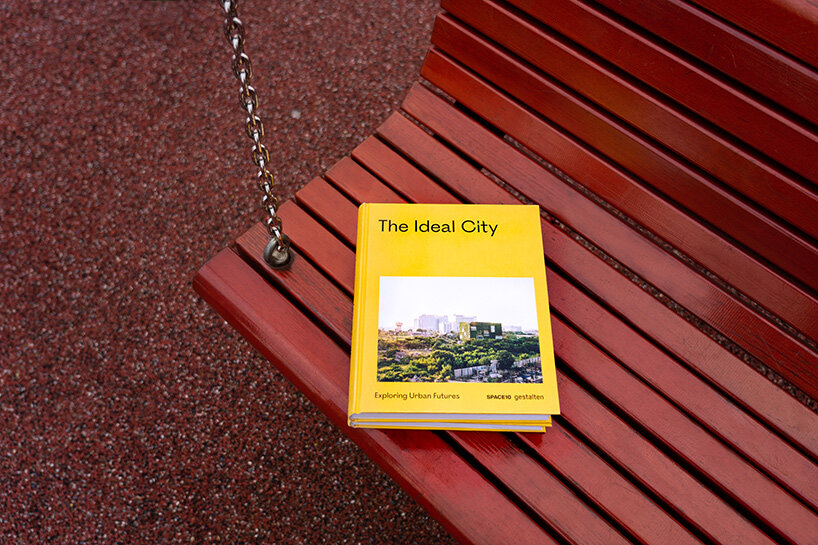
image by anne-sophie rosenvinge







